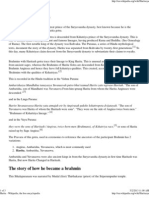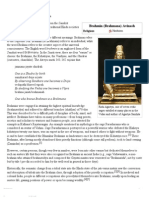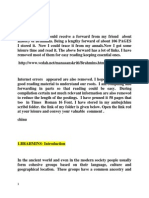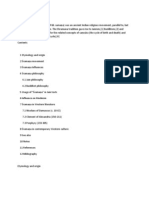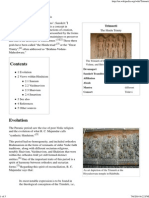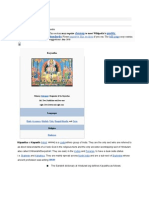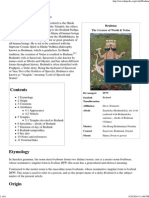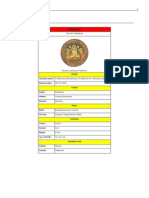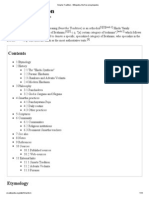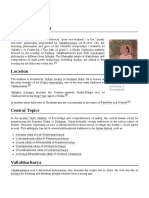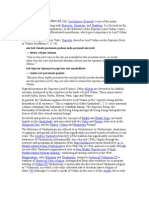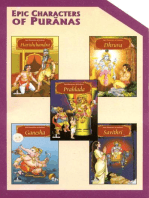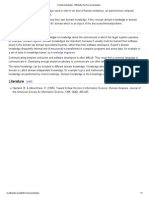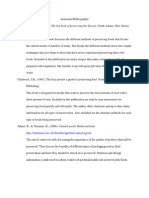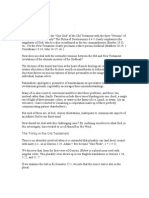Brahmin
Brahmin
Uploaded by
nieotyagiCopyright:
Available Formats
Brahmin
Brahmin
Uploaded by
nieotyagiOriginal Description:
Copyright
Available Formats
Share this document
Did you find this document useful?
Is this content inappropriate?
Copyright:
Available Formats
Brahmin
Brahmin
Uploaded by
nieotyagiCopyright:
Available Formats
9/24/13
Brahmin - Wikipedia, the free encyclopedia
Brahmin (/brmn/; also called Brahmana ; from the Sanskrit brhmaa ) is traditionalHindu societies of India and Nepal. Brahman, Brahmin, and Brahma have different meanings. Brahman refers to the Supreme Self. Brahmin (or Brahmana) refers to an individual belonging to the Hindu priest, artists, teachers, technicians class (varna or pillar of the society) and also to an individual belonging to the Brahmin tribe/caste into which an individual is born; while the word Brahma refers to the creative aspect of the universal consciousness or God. Because the priest / Acharya is knowledgeable about Brahman, and is responsible for religious ritualsin temples and homes and is a person authorized after rigorous training in vedas (sacred texts of knowledge) and religious rituals and provide advice and impart knowledge of God to members of the society and assist in attainment of moksha, the liberation from life cycle; the priest / Acharya class is called "Brahmin varna." The English word brahmin is an anglicized form of the Sanskrit wordBrhmana. According to ancient Indian philosophers and scholars, the humansociety comprises four pillars or classes called varnas or colors. In the ancient Indian texts such as Smritis, vedas, upanishads, puranas , etc., these four "varnas" or classes or pillars of the society are: thepriests / Acharya (Brahmins), the rulers and military (Kshatriyas), themerchants and agriculturists(Vaishyas), and the Assistants (Shudras). Brahmin priests / Acharya were engaged in attaining the highest spiritual knowledge(brahmavidya) of Brahman (God) and adhered to different branches (shakhas) of Vedas. Brahmin priest is responsible for religious rituals in temples and homes of Hindus and is a person authorized after rigorous training in vedas and sacred rituals, and as a liaison betweenhumans and the God. In general, as family vocations and businesses are inherited,priesthood used to be inherited among Brahmin priest families, as it requires years of practice of vedas from childhood after proper introduction to student life through a religiousinitiation called upanayana at the age of about five. The Brahmin priest has to wake up at four in the morning and bathe in cold water, rain or shine, warm or cold. Then, without a break, he has to perform one rite after another:sandhyavandana, brahmayajna,[1] aupasana, puja, vaisvadeva and at least one of the 21 sacrifices for hours, in front of a sacred fire, with all the heat and smoke. So many are the vows and the fasts the priest must keep, and as many are the ritual baths the priest must take in a day. The dharmasastras require that the Brahmin priest adheres to the rules and rituals imposed on the priest not only during the performance of so many rites and rigorous discipline, but also every second of his life, because the Brahmin priest life is dedicated to God. The priest performing rituals, may have his first meal at 1 or 2 PM (and on the day of asraddha (cremation)) it will be three or four PM). The Brahmin priest's vegetarian meal and dwelling are simple and humble.[2][3] Individuals from the Brahmin castes/tribes have taken on many professions such as priests,ascetics and scholars to warriors and business people, according to 12th century poetKalhana, in Rajatarangini.[4] According to Valmiki, a hunter and Sanskrit poet, in Ramayanahistory, Brahmin sage Parashurama is an Avatar (divine incarnate representation) of LordVishnu, who takes up arms against kings to deliver justice. Sage Parashurama is portrayed as a powerful warrior who defeated the Haiheya kshatriyas twenty one times, was an expert in martial arts and the use of weapons, and trained others to fight without weapons.[5] Krishna Dwaipayana Vyasa, son of a Brahmin sage Parashara and a fisher womanSatyavathi, in his Mahabharata, describes several warriors belonging to Brahmin caste/tribe, such as Dronacharya, Kripacharya, Parashurama etc., who were professors in the schools of martial arts and the art of war.
Contents [hide] 1 History 2 Practices
en.wikipedia.org/wiki/Brahmin 1/6
9/24/13
Brahmin - Wikipedia, the free encyclopedia
3 Brahmin communities 4 Pancha-Gauda 4.1 Sarasvat Brahmins 4.2 Kanyakubja Brahmins 4.3 Utkala Brahmins 5 Pancha-Dravida 5.1 Andhra Pradesh 5.2 Maharashtra 5.3 Karnataka 5.4 Tamil Nadu 5.5 Kerala 5.6 Nepali Brahmins 6 Sampradayas 6.1 Smartism 6.2 Vaishnavism 6.3 Shaivism 6.4 Other sects 7 Burma (Myanmar) 8 Thailand 9 See also 10 References 11 Further reading 12 External links
History
[edit source]
Main article: History of Hinduism According to Purusha Sukta, a Rigveda hymn, Brahmins were born from purusha's(vishwakarma ) face.[6][7] Most sampradayas (sects) of modern Brahmins claim to take inspiration from the Vedas. According to orthodox Hindu tradition, the Vedas are apaurueya and andi (beginning-less), and are revealed truths of eternal validity. The Vedas are considered ruti ("that which is heard") and are the paramount source on which Brahmin tradition claims to be based. ruti texts include the four Vedas (the Rigveda, the Yajurveda, the Samaveda and theAtharvaveda), and their respective Brahmanas, Aranyakas and Upanishads. Apart from clerical positions, Brahmins have also historically been ministers (known as Sachivas or Amatyas ) in dynasties.
Practices
[edit source]
Brahmins, basically adhere to the principles of the Vedas, related to the texts of the rutiand Smriti which are some the foundations of Hinduism, and practice Sanatana Dharma. Vedic Brhmaas have six occupational duties, of which three are compulsory studying the Vedas, performing Vedic rituals and practicing dharma. By teaching the insights of the Vedic literature which deals with all aspects of life including spirituality, philosophy, yoga, religion, rituals, temples, arts and culture, music, dance, grammar, pronunciation, metre, astrology, astronomy, logic, law, medicine, surgery, technology, martial arts, military strategy, etc. By spreading its philosophy, and by accepting back from the community, the Brahmins receive the necessities of life.[citation needed] Male members of all Brahmin sects wear the Yagnopaveetham (Hindi: or sacred thread) that is a symbol of initiation to the Gayatri recital. This ritual is often referred to asUpanayana. This marks the learning of the Gayatri
en.wikipedia.org/wiki/Brahmin 2/6
9/24/13
Brahmin - Wikipedia, the free encyclopedia
hymn. Brahmin sects also generally identify themselves as belonging to a particular Gotra, a classification based on patrilineal descent, which is specific for each family and indicates their origin.[citation needed]
Brahmin communities
[edit source]
This section does not cite any references or sources.Please help improve this section by adding citations to reliable sources. Unsourced material may be challenged and removed. (August 2013) The Brahmin castes may be broadly divided into two regional groups: Pancha-GaudaBrahmins from the Northern part of India (considered to be the region north of the Vindhyamountains) and Pancha-Dravida Brahmins from the region south of the Vindhya mountains as per the shloka of Kalhana. Saraswat, Kanyakubja, Gaud, Utkala and Mithila form the Pancha Guada Karnataka, Telangaa, Dravida, Maharashtra and Gurjarat form the Pancha Dravida
Pancha-Gauda
[edit source]
Main article: Pancha-Gauda The Brahmins from Srasvata, Kanyakubja, Gauda, Mithilaand Utkala, who with passage of time spread to North East, East and West, were called Pancha Gauda. This group is originally from Uttarapatha (ryvarta). Pancha Gauda Brahmins are divided into five main categories:
Sarasvat Brahmins
Saraswat Brahmin Kashmiri Pandits
[edit source]
Goud Saraswat Brahmin Chitrapur Saraswat Brahmin Rajapur Saraswat Brahmin Kudaldeshkar Gaud Brahman Mohyal
Statue of Raja Ram Mohan Roy, a Kulin Brahmins, in College Green, Bristol, England
Kanyakubja Brahmins
Assamese Brahmins Kamrupi Brahmins Kanyakubja Brahmin Bhumihar Brahmin Saryupareen Brahmin Sanadya Brahmin Bengali Brahmin Nepali Brahmins Goswami/Gossain Manipuri Brahmin Garhwali Brahmins Sakaldwipiya Brahmins
en.wikipedia.org/wiki/Brahmin
[edit source]
Adi Guru Shri Gauapdchrya, the grand
3/6
9/24/13
Brahmin - Wikipedia, the free encyclopedia
Utkala Brahmins
[edit source]
The Sanskrit text Brhmaotpatti-Mrtaa by Pt. Harikrishna stri mentions that a king named Utkala invited Brahmins from the Gangetic Valley to perform ayajna in Jagannath-Puri in Odisha. When the yajna ended, these Brahmins laid the foundation of Lord Jagannath there and settled around Odisha,Jharkhand and Medinipur. The Utkala Brahmins are of three classes 1) Shrautiya (vaidika), 2) Sevayata and 3) Halua Brahmins.
guru of Shri Adi Shankaracharya and the first historical proponent of Advaita Vedanta, also believed to be the founder of Shri Gaudapadacharya Math.
Pancha-Dravida
[edit source]
Brahmins who live in south of Vidhya mountains are called Pancha-Dravida Brahmins and they are divided into following groups. Drava means Water in sanskrit. Peninsular area in India surrounded by water is "Dravida". Karnataka Telugu Dravida (Tamil Nadu & Kerala) Maharashtra Parts of Gujarat
Andhra Pradesh
[edit source]
Brahmins of Andhra Pradesh known as Telugu Brahmins are broadly classified into six groups: Vaidiki Brahmins, Niyogi,Dravida Brahmins and Vaikhnasa.[8] Niyogis are further divided into the following subcategories: Nandavarika Niyogi, Prathama Shakha Niyogi, Aaru Vela Niyogulu, Karanaalu, Sistukaranalu, Karana kamma vyaparlu, Karanakammulu.[9]
Maharashtra
[edit source]
See also: Chitpavan Konk anastha Brahmin, Deshastha Brahmin, and Karhade Brahmin During the days of Maratha India, these Marathi/Konkani Brahmins primarily served as prime ministers or Peshwas,[10] apart from taking up military jobs and converged into the sovereign or the Chhatrapati of Satara. One of the notable Peshwa families is the Bhat family, who happen to be Chitpavan Konkanastha Brahmins.[11] They took up military jobs [12] and ended up being the de facto head[13] of the Maratha Dynasty.[14] Originally the Chitpavan held a low rank in the social hierarchy amongst Marathi Brahmins, however in modern times they enjoy the same social ranking with Deshastha and Karhade Brahmins, inter-marriages between these three communities is now very common.
Karnataka
[edit source]
Kannada Brhmans( ): The Brhmans of the Carnatic, or the Canarese country. The Canarese area comprises Mysore State, and the British Districts of Canara, Dharwar and Belgaum.[15] Tuluva Brahmins,[16] which consist of Kandavara Brahmins, Karhade Brahmins, Padia Brahmins, Saklapuri Brahmins, Shivalli Brahmins, Smartha Shivalli Brahmins, Sthanika Brahmins, Padarthi Brahmins
Tamil Nadu
[edit source] This section does not cite any references or sources.Please help improve this section by adding citations to reliable sources. Unsourced material may be challenged and removed. (September 2013)
en.wikipedia.org/wiki/Brahmin
4/6
9/24/13
Brahmin - Wikipedia, the free encyclopedia
Iyengar (sub-divided into Vadakalai and Thenkalai) Iyer (sub-divided further into Vadama, Vathima,Brahacharanam, Ashtasahasram, Sholiyar, Dikshitar, Kaniyalar, Prathamasaki)keasiya
Kerala
[edit source]
Kerala Brahmins include the following categories of Brahmins:Nambudiri, Embranthiri, Pushpaka Brahmin (subdivided intoNambissans and Unnis), Sharada Brahmins.[citation needed]
Nepali Brahmins
[edit source]
Statue of Sir K.Sheshadri Iyer in Cubbon Park atBangaluru
Bahun is a colloquial Nepali term for a member of the Pahari or "Hill" Brahmin ( ) caste, who are traditionally educators, scholars and priests of Hinduism. They are also known as Barmu in Newari, Bavan in Kham. Brahmins are the second largest caste group in Nepal (12.18% of the population), with the Chhetri (Kshatriya) being the first (16.60%).[17]
Sampradayas
Smartism
[edit source]
[edit source]
Smartism (or Smarta Sampradaya, Smarta Tradition, as it is termed in Sanskrit) is a liberal or nonsectarian denomination of the Hindu religion. This tradition is based on the Advaithic teachings of Adi Sankaracharya. He united various sects of Hinduism under on umbrella by accepting all the major Hindu deities as forms of the one Brahman. He implored the Smarthas to have an Ishta devatha in the form of Siva, Sakthi, Vishnu, Ganesha, Murugan (Subrahmanya) or Sun. The term Smarta refers to adherents who follow the Vedas andShastras.[citation needed]
Vaishnavism
[edit source]
One form of Vaishnavism is Madhwa (Dwaita Sampradaya or Madhva Sampradaya), and the other is Sri Vaishnava (Vishishtadvaita sampradaya). Madhwa Brahmins are mainly located in the Carnatic plains and some of them are seen in Andhra, Maharashtra, Punjab, Tamil Nadu and Kerala. They follow the teachings of Sri Madhvacharya, who was born in South Canara district of Karnataka in the 12th Century. He preached Dvaita, which says that God and atma (soul) are different entities, which is contradictory to the teachings of Sri Adi Sankaracharya, who preached Advaita vedanta (non-duality). In South India, Sri Vaishnava sampradayam was propagated by Srimad Ramanujacharya.Any way all the three philosophers though different in their philosophies believed Lord Vishnu to be the supreme soul.
Shaivism
[edit source]
Shaivism (sometimes called Shivaism) is a belief system where Lord Shiva is worshipped as the Supreme Lord. It is a derivative faith of the core Vedic tradition.[citation needed] Saiva sects contains many subsects, such as Asdisaivas, Rudrasaivas, Veerasiavas, Paramasaivas, etc.Ravana, the ruler of Lanka in the Hindu epic Ramayana, was a staunch Siva devotee, who was the grandson of creator Brahma.
Other sects
[edit source]
There are additional sampradayas, which are not as widely followed: The Mahima Dharma or "Satya Mahima Alekha Dharma" was founded by the Brahmin Mukunda Das of presenten.wikipedia.org/wiki/Brahmin 5/6
9/24/13
Brahmin - Wikipedia, the free encyclopedia
day Odisha, popularly known by followers as Mahima Swami according to the Bhima Bhoi text.[18] He was born in the last part of the 18th century, in the former state of Baudh, a son of Ananta Mishra. He was Brahmin by caste as mentioned in Mahima Vinod of Bhima Bhoi in Vol.11. This sampradaya is similar to Vaishnavism. Although the members of this sect do not worship Lord Vishnu as their Ishta-Deva, they believe that the Srimad Bhagavatam is sacred. The founder of this sect was a Vaishnavite before founding the new order.[18] This sampradaya was founded in the latter part of the 18th century.[18]
Burma (Myanmar)
[edit source]
This article contains Burm ese script. Without proper rendering support, you may see question marks, boxes, or other symbolsinstead of Burmese script.
Historically, Brahmins, known as ponna ( ) in modernday Burmese, formed an influential group in Burma prior to British colonialism. Until the 1900s, ponna referred to Indians who had arrived prior to colonial rule, distinct from k ala, Indians who arrived during British rule. During theKonbaung dynasty, court Brahmins were consulted by kings before moving royal capitals, waging wars, making offerings to Buddhist sites like the Mahamuni Buddha, and for astrology.[19]Burmese Brahmins can be divided into four general groups, depending on their origins: Manipur Brahmins (Burmese: ): Brahmins who were sent to Burma afterManipur became a Burmese vassal state in the 1700s and ambassadors from Manipur Arakanese Brahmins (Burmese: ): Brahmins brought to Burma from Arakan after it was conquered by the Konbaung king Bodawpaya Sagaing Brahmins: the oldest Brahmins in Burmese society, who consulted the Pyu,Burman[disambiguation needed ] and Mon kingdoms prior to the Konbaung dynasty
Manipuri astrologers and Brahmins in Burma, 1900
Indian Brahmins: Brahmins who arrived with British colonial rule when Burma became a part of the British Raj According to Burmese chronicles, Brahmins in Burma were subject to the four-caste system, which included brahmanas ( ), kshatriyas ( ), vaishya ( ), and shudra ( ). Because the Burmese monarchy enforced the caste system for Indians, Brahmins who broke caste traditions and laws were subject to punishment. In the Arakanese kingdom, punished Brahmins often became k yun ponna ( ), literally 'slave Brahmins', who made flower offerings to Buddha images and performed menial tasks. During the Konbaung dynasty, caste was indicated by the number of salwe (threads) worn; Brahmins wore nine, while the lowest caste wore none. Brahmins are also fundamental in the Nine-God cult, called the Nine Divinities (Phaya Ko Su ) which is essentially a Burmese puja(puzaw in Burmese) for appeasing nine divinities, Buddha and the eight arahats, or a group of nine deities, five Hindu gods and four nat spirits.[19] This practice continues to be practiced in modern-day Burma.
Thailand
[edit source]
Brahmins in Thailand are known as 'Phram' or 'Paahm' (Thai: ) and claim ancestry to Indian Brahmins who migrated to Thailand in the 6th century AD[20]
en.wikipedia.org/wiki/Brahmin
6/6
You might also like
- Handel Messiah - All Trumpet 1 PartsDocument64 pagesHandel Messiah - All Trumpet 1 Partsmarcilio santana75% (4)
- Niyogis Are A Sect of Brahmins and Are Predominantly TeluguspeakersDocument38 pagesNiyogis Are A Sect of Brahmins and Are Predominantly TeluguspeakersAnonymous LFgO4WbID100% (1)
- Nimbarka SampradayaDocument10 pagesNimbarka Sampradayapatrick876Noch keine Bewertungen
- SamayacharaDocument10 pagesSamayacharasatyajit197450% (2)
- Haritahasa Gotra HistoryDocument3 pagesHaritahasa Gotra Historyfinvista100% (3)
- The Pinto RevoltDocument2 pagesThe Pinto RevoltAbdul Khan0% (1)
- Brahmin - Wikipedia, The Free EncyclopediaDocument8 pagesBrahmin - Wikipedia, The Free EncyclopediaShree Vishnu ShastriNoch keine Bewertungen
- Brahmin - Wikipedia, The Free EncyclopediaDocument18 pagesBrahmin - Wikipedia, The Free EncyclopediaVivekananda Ganjigunta NarayanaNoch keine Bewertungen
- Harit/Harita GotraDocument20 pagesHarit/Harita GotraSairam ModumudiNoch keine Bewertungen
- Brahmins of Andhra Pradesh16Document22 pagesBrahmins of Andhra Pradesh16Anand Rao100% (1)
- BrahminDocument30 pagesBrahminArun KumarNoch keine Bewertungen
- Brahmin - FamilypediaDocument12 pagesBrahmin - FamilypediaShree Vishnu Shastri100% (1)
- Shri Krishna Chaitanya Charita MahakavyaDocument33 pagesShri Krishna Chaitanya Charita Mahakavyaavisan100% (1)
- History of BrahminsDocument58 pagesHistory of BrahminsAntonio JohnsonNoch keine Bewertungen
- Gotras and Pravaras - How Gotras Formed and Its HistoryDocument18 pagesGotras and Pravaras - How Gotras Formed and Its Historysaaisun100% (2)
- The ShramanaDocument18 pagesThe ShramanaGirish Narayanan100% (2)
- Utkal BrahminsDocument21 pagesUtkal BrahminsforeverbikasNoch keine Bewertungen
- BrahminDocument12 pagesBrahminMahi Pati JoshiNoch keine Bewertungen
- HINDU DHARMA (SACRED tEXTS)Document3 pagesHINDU DHARMA (SACRED tEXTS)Arcelita Aninon MagbanuaNoch keine Bewertungen
- Project On JainisamDocument3 pagesProject On JainisamAjit Jain100% (2)
- Bengali Brahmins - Wikipedia, The Free EncyclopediaDocument8 pagesBengali Brahmins - Wikipedia, The Free EncyclopediaShree Vishnu ShastriNoch keine Bewertungen
- Lesson 1 - HinduismDocument10 pagesLesson 1 - HinduismVictor Noel AlamisNoch keine Bewertungen
- Hinduism ReviewerDocument3 pagesHinduism Reviewerjansennkiel belludoNoch keine Bewertungen
- Brahmins IncyclopediaDocument23 pagesBrahmins IncyclopediaAbhishek MishraNoch keine Bewertungen
- The Three Great AcharyasDocument5 pagesThe Three Great Acharyasek4nt4Noch keine Bewertungen
- Indian ReligionsDocument5 pagesIndian ReligionsLeonardo R. Aldovino, Jr.Noch keine Bewertungen
- BRAHMINDocument5 pagesBRAHMINIYERBKNoch keine Bewertungen
- Tatva Vaada PhilosophyDocument210 pagesTatva Vaada PhilosophyypraviNoch keine Bewertungen
- Srivaishnava Tutorial Part2Document17 pagesSrivaishnava Tutorial Part2Rengarajan ThiruvengadaswamyNoch keine Bewertungen
- 20 655Document14 pages20 655Manoj VarrierNoch keine Bewertungen
- Gayatri Mahima MadhuriDocument114 pagesGayatri Mahima MadhuriArjuna VallabhaNoch keine Bewertungen
- Legal History 1 - Varnashrama SystemDocument12 pagesLegal History 1 - Varnashrama SystemYuvraj Singh TenguriyaNoch keine Bewertungen
- TrimurtiDocument5 pagesTrimurtiabhi16Noch keine Bewertungen
- BrahmacharyaDocument8 pagesBrahmacharyaPushpa B SridharanNoch keine Bewertungen
- House of Vedas & AyurvedaDocument85 pagesHouse of Vedas & AyurvedaGurudutta MishraNoch keine Bewertungen
- KayasthaDocument28 pagesKayasthaashutoshsrivastava2008100% (1)
- About MadhvaDocument4 pagesAbout MadhvaUpendran BoovarahaNoch keine Bewertungen
- Iwrbs Las2q4Document4 pagesIwrbs Las2q4Shalene Dale Panague CamayudoNoch keine Bewertungen
- Brahma - Wikipedia, The Free EncyclopediaDocument6 pagesBrahma - Wikipedia, The Free EncyclopediaShree Vishnu ShastriNoch keine Bewertungen
- Sri MahavirDocument7 pagesSri Mahavirankiite4678Noch keine Bewertungen
- Upanishads Bhagavad Gita Brahma Sutras Prasthanatrayi Upanishads Sruti Brahma Sutras Bhagavad Gita SmritiDocument2 pagesUpanishads Bhagavad Gita Brahma Sutras Prasthanatrayi Upanishads Sruti Brahma Sutras Bhagavad Gita Smriti16SA125.KaranThakkarNoch keine Bewertungen
- HinduismDocument34 pagesHinduismThird GabineteNoch keine Bewertungen
- Bhagavatam-Vedanta SutrasDocument6 pagesBhagavatam-Vedanta SutrasGopal VenkatramanNoch keine Bewertungen
- Dharmaguptaka - Wikipedia, The Free EncyclopediaDocument4 pagesDharmaguptaka - Wikipedia, The Free EncyclopediaAung Kyaw MoeNoch keine Bewertungen
- Smarta TraditionDocument13 pagesSmarta TraditionMurali KrishnanNoch keine Bewertungen
- Revision Notes On History: Jainism and BuddhismDocument3 pagesRevision Notes On History: Jainism and BuddhismtroootskyNoch keine Bewertungen
- Hinduism: Reporter: Lea Esquejo Maica RubillaDocument44 pagesHinduism: Reporter: Lea Esquejo Maica RubillaMae HailarNoch keine Bewertungen
- The Difference in Between Sramana and Brahmana TraditionDocument1 pageThe Difference in Between Sramana and Brahmana Traditionbullking100% (2)
- Brah Marsh IDocument1 pageBrah Marsh InieotyagiNoch keine Bewertungen
- ShuddhadvaitaDocument4 pagesShuddhadvaitapatrick876Noch keine Bewertungen
- Bharadvaja - WikipediaDocument5 pagesBharadvaja - WikipediakamaalNoch keine Bewertungen
- BrahmaDocument3 pagesBrahmarwerwerNoch keine Bewertungen
- Assam Vaisnavism and Sankaradeva SanghaDocument3 pagesAssam Vaisnavism and Sankaradeva SanghaDeepankar Axom GogoiNoch keine Bewertungen
- VaishnavismDocument3 pagesVaishnavismvrohit308Noch keine Bewertungen
- Sant RavidasDocument20 pagesSant RavidasAnonymous ktNyZTNoch keine Bewertungen
- Buddhism & JainismDocument40 pagesBuddhism & JainismAnandakrishnan A SNoch keine Bewertungen
- IWRBS Calibrated Q1 Week 8Document9 pagesIWRBS Calibrated Q1 Week 8Rizza Marie SecullesNoch keine Bewertungen
- Religious Movements (600 BCE) - JainismDocument4 pagesReligious Movements (600 BCE) - Jainismsahaarit30Noch keine Bewertungen
- Bhakti Ratnavali - An Anthology from Srimad BhagavataFrom EverandBhakti Ratnavali - An Anthology from Srimad BhagavataNoch keine Bewertungen
- Epic Characters of Purānas: Epic Characters of PuranasFrom EverandEpic Characters of Purānas: Epic Characters of PuranasRating: 5 out of 5 stars5/5 (2)
- Self Determination TheoryDocument13 pagesSelf Determination Theorynieotyagi100% (1)
- Elaboration Likelihood ModelDocument3 pagesElaboration Likelihood ModelnieotyagiNoch keine Bewertungen
- Lateral ThinkingDocument2 pagesLateral ThinkingnieotyagiNoch keine Bewertungen
- Emotional ContagionDocument4 pagesEmotional ContagionnieotyagiNoch keine Bewertungen
- Epiphany (Feeling)Document2 pagesEpiphany (Feeling)nieotyagiNoch keine Bewertungen
- Executive FunctionsDocument9 pagesExecutive FunctionsnieotyagiNoch keine Bewertungen
- Moral RelativismDocument5 pagesMoral RelativismnieotyagiNoch keine Bewertungen
- Rational Choice TheoryDocument6 pagesRational Choice TheorynieotyagiNoch keine Bewertungen
- Creativity TechniquesDocument2 pagesCreativity TechniquesnieotyagiNoch keine Bewertungen
- Stream of Consciousness (Psychology) ADocument1 pageStream of Consciousness (Psychology) AnieotyagiNoch keine Bewertungen
- Creative WritingDocument4 pagesCreative WritingnieotyagiNoch keine Bewertungen
- Speech ActDocument6 pagesSpeech ActnieotyagiNoch keine Bewertungen
- Impairment: Acute Self-AwarenessDocument1 pageImpairment: Acute Self-AwarenessnieotyagiNoch keine Bewertungen
- SentienceDocument3 pagesSentiencenieotyagiNoch keine Bewertungen
- Creative Problem SolvingDocument3 pagesCreative Problem Solvingnieotyagi100% (1)
- Mental ModelDocument6 pagesMental ModelnieotyagiNoch keine Bewertungen
- Domain KnowledgeDocument1 pageDomain KnowledgenieotyagiNoch keine Bewertungen
- Self-Concept - Wikipedia, The Free EncyclopediaDocument7 pagesSelf-Concept - Wikipedia, The Free Encyclopedianieotyagi100% (1)
- Self-Knowledge (Psychology)Document10 pagesSelf-Knowledge (Psychology)nieotyagiNoch keine Bewertungen
- History of The Term: Nous Intelligere. IntellectusDocument10 pagesHistory of The Term: Nous Intelligere. IntellectusnieotyagiNoch keine Bewertungen
- History of The Term: Nous Intelligere. IntellectusDocument10 pagesHistory of The Term: Nous Intelligere. IntellectusnieotyagiNoch keine Bewertungen
- MMLDM Intro Lesson (2019)Document25 pagesMMLDM Intro Lesson (2019)Arvin LisingNoch keine Bewertungen
- RPH Report, Did Rizal RetractDocument18 pagesRPH Report, Did Rizal RetractTulibas Karl Jade J - BSN 1E100% (4)
- Home Following Answer Spaces Notifications: Add QuestionDocument26 pagesHome Following Answer Spaces Notifications: Add QuestionDeepak SehgalNoch keine Bewertungen
- (Mark Coeckelbergh (Auth.) ) Human Being Risk.Document226 pages(Mark Coeckelbergh (Auth.) ) Human Being Risk.Maurício FernandesNoch keine Bewertungen
- K E Hagin ClassicsDocument108 pagesK E Hagin Classicsdeogmozyx100% (2)
- Bahir N OthersDocument37 pagesBahir N Othersfarzana25Noch keine Bewertungen
- Tawheed NoteDocument5 pagesTawheed NoteNor Rizam MazlanNoch keine Bewertungen
- Philippine LiteratureDocument14 pagesPhilippine LiteraturesecretNoch keine Bewertungen
- Swaminarayan - Bliss Sept 2010Document40 pagesSwaminarayan - Bliss Sept 2010Dhaval Miyani100% (2)
- Annotated BibliograpyDocument2 pagesAnnotated BibliograpyjamesrcarricoNoch keine Bewertungen
- Greek LiteratureDocument7 pagesGreek LiteraturemY3co7k3w9Noch keine Bewertungen
- Practices of SufismDocument59 pagesPractices of SufismAzam-Savaşçı Anderson MohammadNoch keine Bewertungen
- Philippine National Police Training ServiceDocument28 pagesPhilippine National Police Training ServiceJulieto ResusNoch keine Bewertungen
- The First House Determines A Lot About What Makes You UniqueDocument21 pagesThe First House Determines A Lot About What Makes You UniqueBoki100% (1)
- BilgramiDocument26 pagesBilgramimohitiertNoch keine Bewertungen
- Dealing With DisunityDocument3 pagesDealing With DisunityDavid SalazarNoch keine Bewertungen
- Quran I C Arabic Patterns ExplainedDocument14 pagesQuran I C Arabic Patterns ExplainedGregoryMorseNoch keine Bewertungen
- The Concept of The Hermaphrodite: Agathe and Ulrich in Musil's NovelDocument9 pagesThe Concept of The Hermaphrodite: Agathe and Ulrich in Musil's NovelKenny Gildman100% (1)
- COHEN, Shaye J.D. Common Judaism in Greek and Latin AuthorsDocument20 pagesCOHEN, Shaye J.D. Common Judaism in Greek and Latin AuthorsÉverton MatosNoch keine Bewertungen
- Why Were Michael and Satan Disputing Over The Body of Moses?Document2 pagesWhy Were Michael and Satan Disputing Over The Body of Moses?Molitvena zajednica sv. Mihaela arhanđelaNoch keine Bewertungen
- The Gospel of The KingdomDocument64 pagesThe Gospel of The KingdomeltropicalNoch keine Bewertungen
- The Coming of The WestDocument4 pagesThe Coming of The WestEzra Denise Lubong Ramel100% (1)
- Vishal Chennai CollegeDocument7 pagesVishal Chennai CollegeVishal ChaurasiyaNoch keine Bewertungen
- A Farewell To Arms Chapter 9 SummaryDocument18 pagesA Farewell To Arms Chapter 9 SummaryRaheelNoch keine Bewertungen
- Chuck Missler One God or ThreeDocument3 pagesChuck Missler One God or ThreepallenNoch keine Bewertungen
- 2015.198032.The Digha Nikaya Voll Ii - text - 看图王 PDFDocument398 pages2015.198032.The Digha Nikaya Voll Ii - text - 看图王 PDFMichael JohnNoch keine Bewertungen
- Balinese ArchitectureDocument4 pagesBalinese ArchitectureMa. Clarice Sabilla LomonsodNoch keine Bewertungen
- Giovanni NecromancyDocument8 pagesGiovanni NecromancyKevinNoch keine Bewertungen




